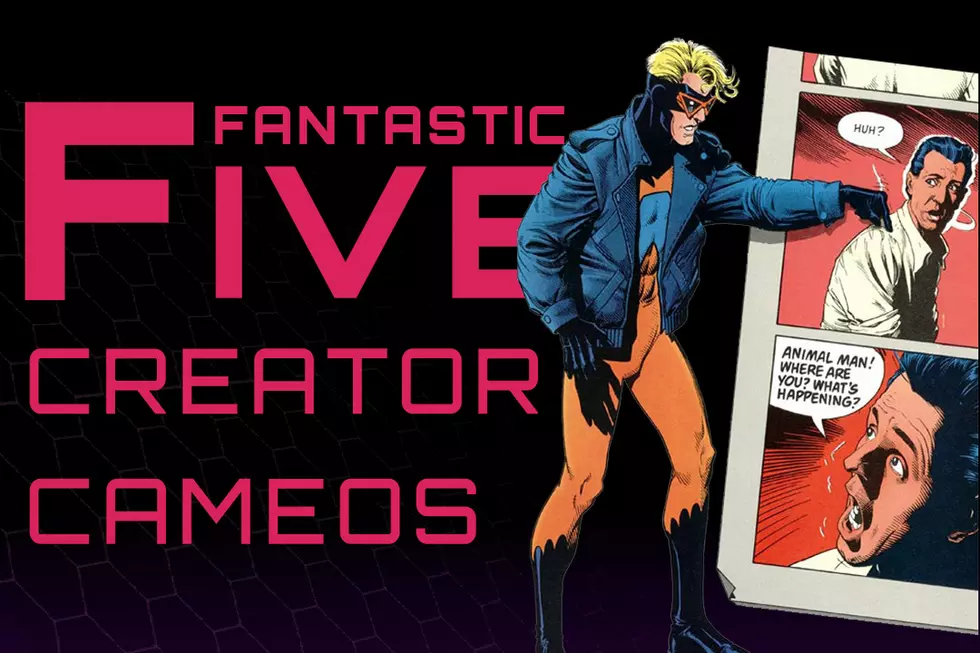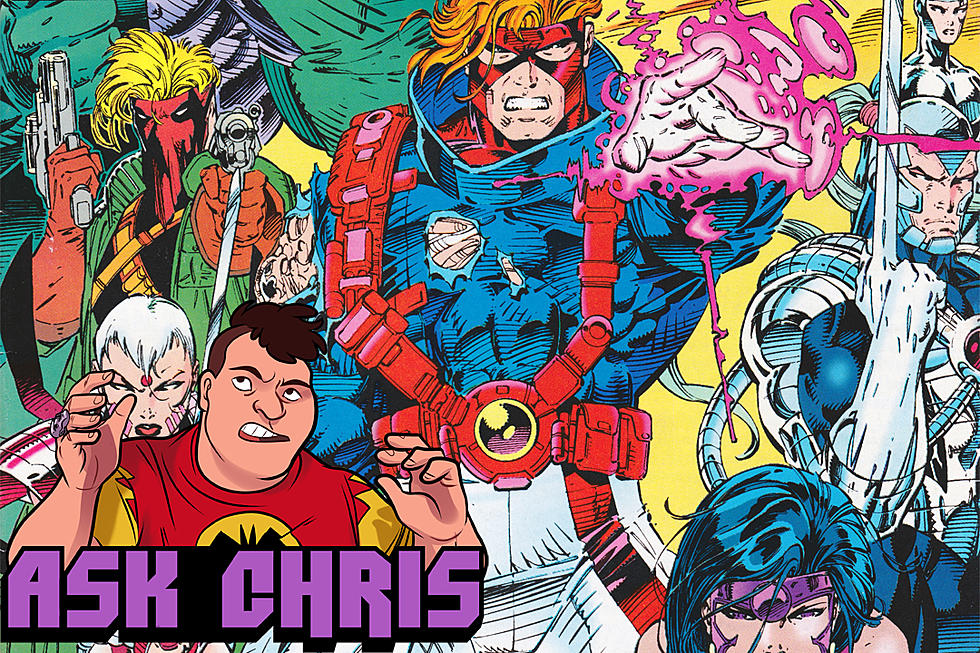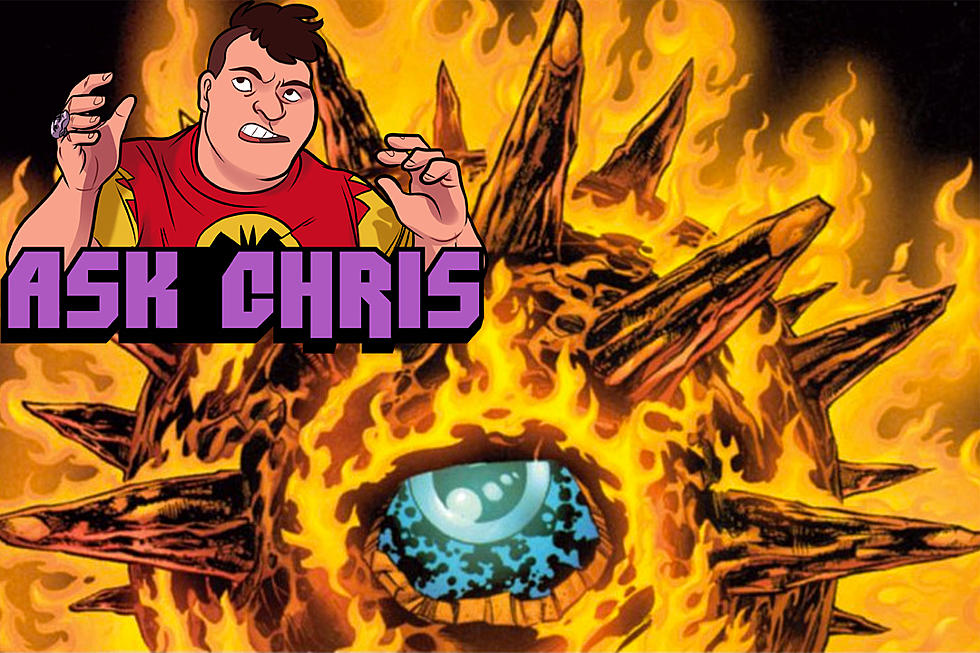
The Multiversity Annotations, Part 7: Mastermen – “You Can Ram Your Siegfried Where The Sun Don’t Shine.”
Teased for years and finally launched in 2014, The Multiversity is a universe-jumping series of DC Comics one-shots tracking the cosmic monitor Nix Uotan and an assemblage of star-crossed heroes as they attempt to save 52 universes and beyond from a trippy cosmic existential threat that, like much of Morrison’s best work, represents something far more mundane and relatable. Tying back into the very first Multiverse story in DC’s history, the heroes of these universes become aware of this threat by reading about it in comic books… comic books that, it turns out, take place in neighboring universes. Indeed, writer Grant Morrison continues his streak of highly metatextual DC cosmic epics with this eight-issue mega-series (plus one Tolkienesque guidebook).
Described by Morrison as “the ultimate statement of what DC is”, The Multiversity naturally offers the reader much beyond the surface level adventure, and that means annotations. Rather than merely filling out checklists of references, my hope with this feature is to slowly unearth and extrapolate a narrative model for Morrison and his collaborators’ work on The Multiversity; an interconnecting web of themes and cause and effect that works both on literal and symbolic levels.
The seventh issue of the series, Mastermen, chronicles the story of Earth-10 (the pre-Crisis Earth-X), a world where the Nazis conquered America and won World War II and the Endless Reich is ruled by Overman, who's built a utopia on Hitler's massacres and doesn't feel very good about that fact.
We first met this version of the character in Final Crisis: Superman Beyond, when he was one of the Supermen on the Ultima Thule who traveled with Superman, Ultraman, Earth-5's Captain Marvel and the rest of the gang to try to stop Mandrakk/Dax Novu from destroying the multiverse, and all of the Monitors.
This issue is drawn by DC co-publisher Jim Lee, with inks by Scott Williams (and an assisting crew), and colors by Alex Sinclair (with assistance from Jeromy Cox).
Page 1
I don't think the comic Sh*tler is reading here is an actual Superman comic; the closest one is Superman #17, where he grabs Hitler and a super-racist caricature of Tojo and forces them to end the war. The pose he's striking here is a clear reference, though, to Captain America Comics #1, where Cap decks Hitler in the face. The back cover references a ubiquitous ad in old comics to send in cash and receive sea monkey eggs in the mail.
Page 2
Colonel von Hammer is Hans von Hammer, a.k.a. Enemy Ace, a WWI & WWII era pilot for the Germans from a number of DC war comics. We know this is taking place in 1938, since that's when Overman mentions his rocket crashed back in Final Crisis: Superman Beyond.
Page 4
Von Braun, of course, is an actual person, a German rocket scientist who ended up working for the Americans after the war because being really good at shooting stuff into the air expunges helping out a dictator who killed millions of people in death camps.
Page 7
The American Crusader is, of course, the Earth-8 Major Comics analogue of Marvel's Captain America. The "overman" (übermensch) that Hitler refers to here is the one from Nietzsche, who inspired the creation of Superman by Siegel and Shuster as well. Hitler was hugely influenced by the idea, and believed that the Aryan genetic pool represented that of the "overman" in a general sense, as opposed to here, where a dude who can survive gunfire in the crib fell out of the sky.
Pages 8-9
Seventeen years later would place this at 1955, although the next page states this sequence (the fall of America) takes place in April 1956, so I guess Overman landed in the Sudetenland in late 1938.
Page 10
I'm not sure what "chandela" refers to here; the only chandela I can find refers to an Indian clan, which doesn't fit much with the Jewish golem tradition or anything a Nazi radio broadcast would be trumpeting. The closest guess I can make is the story of Rabbi Eliyahu of Chelm, who feared his golem would destroy the world until he erased the symbol on its forehead that gave it life.
(This story was referenced back in the first issue of Morrison and Cameron Stewart's Seven Soldiers: The Guardian, when the Guardian defeated a golem monster that way while applying for his superhero job.)
The dude in the lower-right is a really sad-looking Uncle Sam, and the setting of this book burning (for any non-Americans) is the Lincoln Memorial.
Also, April 20 is Hitler's birthday, as well as the St. Patrick's Day of pot smoking.
Page 11
Uncle Sam pockets some Amerikaner propaganda comics while a Nazi dude does his best John Wilkes Booth impression.
Page 12
This scene — Overman crying over Overgirl's demise, referencing the iconic cover of Crisis on Infinite Earths #7 — we actually saw back in Final Crisis #7, since Renee Montoya — the Question at the time — had been the one to discover her corpse back in Final Crisis #3. This time, though, it's a dream, and Lord Broken of the Gentry is there, and Overman's doing the whole "who's knocking at the door?" thing that it looks like we're going to get every issue. Lord Broken here probably represents the evil house of questionable foundation that Overman has built, that is the modern Nazi society of the year 2016 (doing the math from America falling in 1956).
The Earth-10 Justice League he's standing over isn't the one that appears in the rest of the book, but rather the JLAxis from the Countdown era — I have no idea if this is an editorial misfire or this is Overman standing over the corpses of the previous, pre-Flashpoint Earth-10.
Page 13
Yeah, what Overman's describing here is the civilization he leads just as much as it's Lord Broken itself. I'm not sure if Lena is supposed to be Lena Luthor or an Earth-10 variation on Lana Lang or Lois Lane, or just another L.L. for this planet.
Pages 14-15
Jürgen Olsen's narration here takes place far in the future, way past the actual end of the issue (which is just the fall of Metropolis). The Twilight of the New Reichsmen seems a definite reference to the Twilight of the Gods, or Ragnarök in Norse mythology (and the Götterdämmerung in Wagner's Ring Cycle).
Page 16
Apparently, Olsen helped destroy Overman later, talking about "what he'd done." I'm going to state now that I think the story heavily implies that Overman is himself the traitor working with Uncle Sam and the Freedom Fighters against the Endless Reich. I'm not sure how comfortable I am with the implication that Overman's destruction of a Nazi world order is informed by the influence of the Gentry, since the Gentry are the villains of the story and uh... Nazis aren't... very... great. At the same time, a whole mess of people died in the destruction of Metropolis, even if they were citizens of a utopia built on genocide.
Page 17
Uncle Sam — created by Will Eisner — shows up in giant form to ruin a Nazi funeral.
Page 18
The Human Bomb, one of Uncle Sam's Freedom Fighters. Lightning is presumably the Flash analogue on the New Reichsmen.
Pages 20-21
The Eagle's Nest is the Earth-10 analogue of the Justice League's satellite. Its name is a reference to the Kehlsteinhaus, a 50th birthday present for Hitler and a remote chateau for him to entertain visiting dignitaries. I'm unsure as to who the Luthor League would be on Earth-10, but the Star Conqueror is clearly Starro; Konstrukt, the Construct; and Kanjar Ro... well, Kanjar Ro. Classic Justice League villains all. Leatherwing is, apparently, channeling the spirits of every American white person here on Earth-33 who keeps claiming that the problems of slavery and systemic injustice had nothing to do with them, because, you know, it was their ancestors, man.
Page 22
Leatherwing here is apparently the grandson of Enemy Ace, which makes sense. The Uncle Sam poster here is a clear reference to the Uncle Sam war recruitment posters for World War I.
Page 23
As we'll later see, the weapons from a parallel universe are part of a trans-universal weapons cartel the Sivanas are running, which, let's be fair here, is a pretty damn great idea. Lightning is noticing "weird vibrations" due to the vibrational superstructure of the multiverse and the role the Flash plays in traversing it.
Page 24
Get it? A baseball bat? Leatherwing is a bat-man!
Page 25
On display here in the throne room: a Starro in a jar, Hawkman and Adam Strange's helmets, a mother box, and Metron's chair, which Overman is sitting in. I presume these Fourth World elements are "emanations" of the true New Gods on Earth-51, as we discovered back in the Guidebook. Overman and Underwaterman are apparently the only members of the New Reichsmen who aren't total dicks.
Page 26
Uncle Sam is paraphrasing Emma Lazarus's "The New Colossus" here, lines of which appear on the base of the Statue of Liberty. He's apparently set up shop on Ellis Island, the immigration gateway for many cultures entering America for the first half of the 20th century, decorated with a Gone With the Wind poster, Rosie the Riveter, and pictures of (I think) Jackie Robinson and Duke Ellington.
Page 27
Here we meet Darrel and Martha Dane, Doll Man and (presumably) Doll Woman, now reimagined as Jehovah's Witnesses (who were persecuted in Nazi Germany). Uncle Sam is quoting Revelation 18:17 here.
Pages 28-29
We meet the Earth-10 Sivana, apparently working with the Freedom Fighters to foment violence, who's specifically chosen groups persecuted by the Nazi regime to make up the members of the new Freedom Fighters; the new Black Condor is black, and we know from interviews (like this one that Andy Khouri and I did with Morrison, like, two and a half years ago!) that the Ray is gay, and Phantom Lady is Romani. I can only presume that leaves the Human Bomb as Jewish.
This is the last we see of these Freedom Fighters in this issue, though, which seems like a big loss, honestly.
Page 30
Overman is very sad. I love how the stage lighting is drawn like an Iron Cross here, too. And I think Overman's statement here about how the terrorist situation is under control is another clue that he himself might be the dude helping out the Freedom Fighters.
Page 31
So apparently they delayed the Holocaust until Overman left for three years? Presumably to space? And then killed a landfill full of people?
Bayreuth is a city in Germany with an annual music festival, hosting a performance of the Ring of the Nibelung. There is a very excellent argument to be made that this issue parallels the plot details and structure of that opera, and rather than attempt to become an armchair Wagner scholar in less than a month, I'd rather link to the excellent work of GlobeGander (I'm afraid I can't find more past this pseudonym) regarding the links between Mastermen and the Ring Cycle, and the ways in which the former subverts the latter. It's a very thoughtful and informed piece, and I highly recommend you read it yourself as an essential companion piece to this issue, Much as Pax Americana subverts Watchmen, it seems Mastermen exists to subvert Wagner's meisterwerk.
New Bayreuth is presumably in America, and provides an excuse for Jürgen to not be in Metropolis when it's later destroyed by the falling of the Eagle's Nest.
Page 32
Here it's reiterated (as we originally learned in Final Crisis) that Overgirl was a clone of Overman rather than his sister, and we also discover that Lena's been using Kryptonian anti-ageing elixir to stay the same age for 25 years. It's interesting that her crown of triangles gives her the appearance of the Statue of Liberty, to a degree.
Page 34
Overman was watching the Eagle's Nest on the last page, and here we see that he saw nothing unusual in the Human Bomb's physiology. This seems to reinforce the idea that Overman is, in fact, the traitor in the New Reichsmen ranks, since Human Bomb obviously has a healing factor to survive his auto-immolation.
Page 35
Indeed, the beating Leatherwing gave him only served to charge him up to cause this explosion — something Overman surely could have seen and prevented... if he wanted to.
Page 36
This scene is from Götterdämmerung, so the last night of the Ring Cycle, as Siegfried (who GlobeGander posits is represented as the Human Bomb here) is impaled by Hagen. Note Jürgen's narration, stating that Overman knew what would happen next — at this point, I'd say the idea that Overman as the traitor is less implicit and more explicit as Morrison's intent.
Page 37
Uncle Sam, with his size-changing powers (although appearing weirdly holographic here), in what appears to be a practiced confrontation with Overman, as much a performance as the Ring Cycle.
Pages 38-40
One last appearance of the Freedom Fighters as Phantom Lady scares the crowd, and then we reach the end, as Overman's strength "fails" to prevent the Eagle's Nest from falling on Metropolis, destroying it and conveniently beginning the death knell of the cursed empire he's been running.
It's interesting, though, that Jürgen calls Overman 98 years old here, as that would mean that either A) this scene is taking place in 2036 (which has no other textual evidence), B) Overman was born in 1918 and spent 20 years traveling from Krypton to Earth, C) Jürgen is actually referring to Uncle Sam here whose iconic poster was distributed in 1917 and 1918, or D) someone screwed up and they meant to type "seventy-eight."
More From ComicsAlliance









